CMONOC II Common Mode Error Analysis and Structural Region Division Research
Abstract
:1. Introduction
2. Methods
2.1. Improved Singular Spectrum Analysis (ISSA)
2.2. Principal Component Analysis (PCA)
2.3. Independent Component Analysis (ICA)
3. Data
3.1. Data Sources
3.2. Acquisition of Residual Time Series
3.3. Seasonal Term Fitting Results
4. Results of Large Spatial Scale Filtering
4.1. PCA Filtering Results
4.2. ICA Filtering Results
5. Results of Sub-Regions Filtering
5.1. Principles of Fine Determination of Active Tectonic Block Regions
5.2. Comparison of Large Spatial Scale Region and Sub-Regions Filtering Effects
6. Discussion
7. Conclusions
Author Contributions
Funding
Data Availability Statement
Acknowledgments
Conflicts of Interest
References
- Sun, H.; Xu, J.; Jiang, L.; Liu, G.; Zheng, Y.; Yan, H.; bao, L.; Hu, X.; Zhou, J. Research progress of the modern geodesy with its application in Geosciences. Bull. Natl. Nat. Sci. Found. China 2018, 32, 131–140. [Google Scholar] [CrossRef]
- Bo, W.-J. Mainly relative deformation features on China continent revealed by GPS and researches on strong earthquake activities. Prog. Geophys. 2013, 28, 599–606. [Google Scholar] [CrossRef]
- Gan, W.; Li, Q.; Zhang, R.; Shi, H. Construction and Application of Tectonic and Environmental Observation Network of China’s mainland. J. Eng. Stud. 2012, 4, 324–331. [Google Scholar]
- Li, Z.; Yue, J.P.; Li, W.; Lu, D.K. Investigating mass loading contributes of annual GPS observations for the Eurasian plate. J. Geodyn. 2017, 111, 43–49. [Google Scholar] [CrossRef]
- Bock, Y.; Wdowinski, S.; Fang, P.; Zhang, J.; Williams, S.; Johnson, H.; Behr, J.; Genrich, J.; Dean, J.; van Domselaar, M.; et al. Southern California Permanent GPS Geodetic Array: Continuous measurements of regional crustal deformation between the 1992 Landers and 1994 Northridge earthquakes. J. Geophys. Res. Solid Earth 1997, 102, 18013–18033. [Google Scholar] [CrossRef]
- Miao, P.; Xiao, G.; Wang, S.; Zhang, K.; Bai, B.; Guo, Z. Effects of different seasonal fitting methods on the spatial distribution characteristics of common mode errors. Front. Earth Sci. 2023, 11, 1176241. [Google Scholar] [CrossRef]
- Li, Z.; Jiang, W.; Liu, H.; Qu, X. Noise Model Establishment and Analysis of IGS Reference Station Coordinate Time Series inside China. Acta Geod. Et Cartogr. Sin. 2012, 41, 496–503. [Google Scholar]
- Fan, Y.; Wang, H.; Huang, S.; Lu, Q. Analysing the nonlinear motion characteristics of IGS tracking stations using wavelets. Eng. Surv. Mapp. 2014, 23, 5–8. [Google Scholar] [CrossRef]
- Zhang, S.; Li, Z.; He, Y.; Hou, X.; He, Z.; Wang, Q. Extracting of periodic component of GNSS vertical time series using EMD. Sci. Surv. Mapp. 2018, 43, 80–84. [Google Scholar]
- Hu, A.; Wang, T.; Guan, Y.; Yang, Z. Yunnan region vertical GPS time series periodic signal extraction based on SSA. Sci. Surv. Mapp. 2021, 46, 33–40. [Google Scholar] [CrossRef]
- Shu, Y.; Hua, X.; Min, Y.; Teng, H.; Wu, S. Comparison of Common Mode Error Separation Methods for GPS Coordinate Time Series and Their Influences on Noise Model Establishment. J. Geomat. 2023, 48, 20–24. [Google Scholar]
- Márquez-Azúa, B.; DeMets, C. Crustal velocity field of Mexico from continuous GPS measurements, 1993 to June 2001: Implications for the neotectonics of Mexico. J. Geophys. Res. 2003, 108, 2450. [Google Scholar] [CrossRef]
- Dong, D.; Fang, P.; Bock, Y.; Webb, F.; Prawirodirdjo, L.; Kedar, S.; Jamason, P. Spatiotemporal Filtering Using Principal Component Analysis and Karhunen-Loeve Expansion Approaches for Regional GPS Network Analysis. J. Geophys. Res. Solid Earth 2006, 111, B03405. [Google Scholar] [CrossRef]
- Ming, F.; Yang, Y.; Zeng, A. Analysis and Comparison of Common Mode Error Extraction Using Principal Component Analysis and Independent Component Analysis. J. Geod. Geodyn. 2017, 37, 385–389. [Google Scholar]
- Ming, F.; Yang, Y.; Zeng, A.; Zhao, B. Spatiotemporal filtering for regional GPS network in China using independent component analysis. J. Geod. 2017, 91, 419–440. [Google Scholar] [CrossRef]
- Hu, L.; Zhou, Y.; Wang, W. Study on the extraction of common-mode errors in CMONOC. Sci. Surv. Mapp. 2019, 44, 37–42. [Google Scholar] [CrossRef]
- Wang, F.; Dong, D.; Zhang, P.; Sun, Z.; Zhang, Q. Common Mode Error Analysis Based on GPS Station of Chinese Mainland. Earthq. Res. China 2020, 36, 843–856. [Google Scholar]
- Liu, X.; Gao, E.; Luo, Y.; Fu, B. Analysis of Coordinate Time Series of CMONOC GNSS Fiducial Stations Using Principal Component Analysis. J. Geod. Geodyn. 2021, 41, 43–48. [Google Scholar] [CrossRef]
- Wang, H.; Li, W.; Shu, C.; Shum, C.K.; Li, F.; Zhang, S.; Zhang, Z. Assessment of spatiotemporal filtering methods towards optimising crustal movement observation network of China (CMONOC) GNSS data processing at different spatial scales. All Earth 2022, 34, 107–119. [Google Scholar] [CrossRef]
- Wang, J.; Zhou, X.; Zhu, Z.; Liang, L. Research on Elimination of Common Mode Error in Large-Scale GPS Networks. J. Geod. Geodyn. 2018, 38, 78–82. [Google Scholar]
- Xie, S.; Pan, P.; Zhou, X. Research on Common Mode Error Extraction Method for Large—Scale GPS Network. Geomat. Inf. Sci. Wuhan Univ. 2014, 39, 1168–1173. [Google Scholar]
- Yang, B.; Jim, W.; Liu, Z.; Liang, H.; Zhu, S. Identification of common mode error in large spatial domain of GNSS by multi-core function method. J. Geomat. Sci. Technol. 2014, 31, 127–132. [Google Scholar]
- Kreemer, C.; Blewitt, G. Robust estimation of spatially varying common-mode components in GPS time-series. J. Geod. 2021, 95, 95. [Google Scholar] [CrossRef]
- Liu, B.; Dai, W.; Peng, W.; Meng, X. Spatiotemporal analysis of GPS time series in vertical direction using independent component analysis. Earth Planets Space 2015, 67, 189. [Google Scholar] [CrossRef]
- Liu, B.; King, M.; Dai, W. Common mode error in Antarctic GPS coordinate time-series on its effect on bedrock-uplift estimates. Geophys. J. Int. 2018, 214, 1652–1664. [Google Scholar] [CrossRef]
- Serpelloni, E.; Faccenna, C.; Spada, G.; Dong, D.; Williams, S.D. Vertical GPS ground motion rates in the Euro-Mediterranean region: New evidence of velocity gradients at different spatial scales along the NubiaEurasia plate boundary. J. Geophys. Res. Solid Earth 2013, 118, 6003–6024. [Google Scholar] [CrossRef]
- Yuan, P.; Jiang, W.; Wang, K.; Sneeuw, N. Effects of spatiotemporal filtering on the periodic signals and noise in the GPS position time series of the crustal movement observation network of China. Remote Sens. 2018, 10, 1472. [Google Scholar] [CrossRef]
- Wu, S.; Nie, G.; Liu, J.; Wang, K.; Xue, C.; Wang, J.; Li, H.; Peng, F.; Ren, X. A sub-regional extraction method of common mode components from IGS and CMONOC stations in China. Remote Sens. 2019, 11, 1389. [Google Scholar] [CrossRef]
- Zhang, P.; Deng, Q.; Zhang, G.; Ma, J.; Gan, W.; Min, W.; Mao, F.; Wang, Q. Strong seismic activity and active tectonic-blocks region in mainland China. Sci. China Ser. D-Earth Sci. 2003, 33, 9. (In Chinese) [Google Scholar] [CrossRef]
- Liang, S. Three-dimensional Velocity Field of Present-day Crustal Motion of the Tibetan Plateau Inferred from GPS Measurements. Ph.D. Thesis, Institute of Geology, China Earthquake Administration, Beijing, China, 2014. [Google Scholar]
- Nikolaidis, R. Observation of Geodetic and Seismic Deformation with the Global Positioning System. Ph.D. Thesis, University of California, Los Angeles, CA, USA, 2002. [Google Scholar]
- Chen, Q.; van Dam, T.; Sneeuw, N.; Collilieux, X.; Weigelt, M.; Rebischung, P. Singular spectrum analysis for modeling seasonal signals from GPS time series. J. Geodyn. 2013, 72, 25–35. [Google Scholar] [CrossRef]
- Xiang, Y.; Yue, J.; Li, Z. Joint analysis of seasonal oscillations derived from GPS observations and hydrological loading for mainland China. Adv. Space Res. 2018, 62, 3148–3161. [Google Scholar] [CrossRef]
- Hassani, H. Singular spectrum analysis:methodology and comparison. J. Data Sci. 2007, 5, 239–257. [Google Scholar] [CrossRef]
- Xie, G.; Tao, T.; Ma, M.; Hu, S. Analysis of spatial and temporal variation of groundwater storage in Anhui Province using GRACE satellite. J. Hefei Univ. Technol. Nat. Sci. 2024, 47, 367–372+378. [Google Scholar]
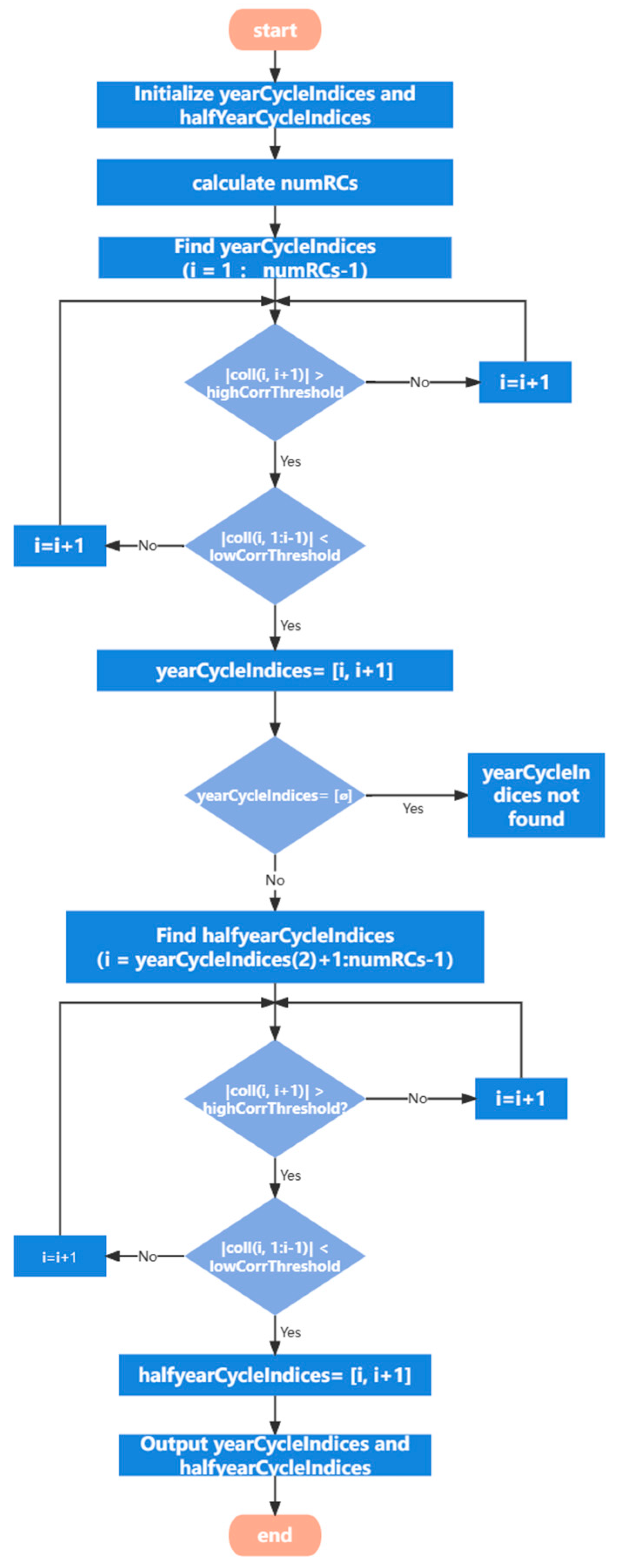
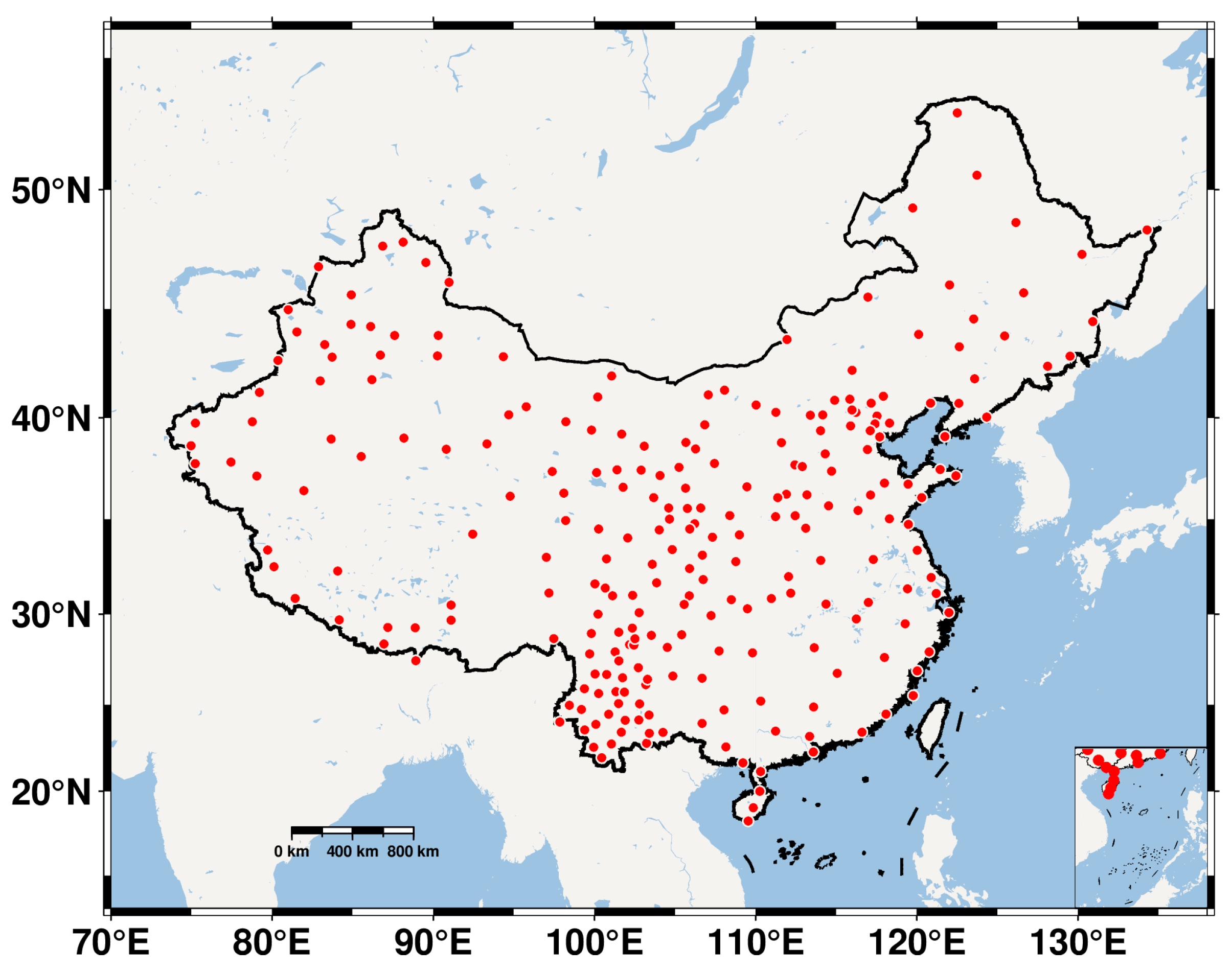
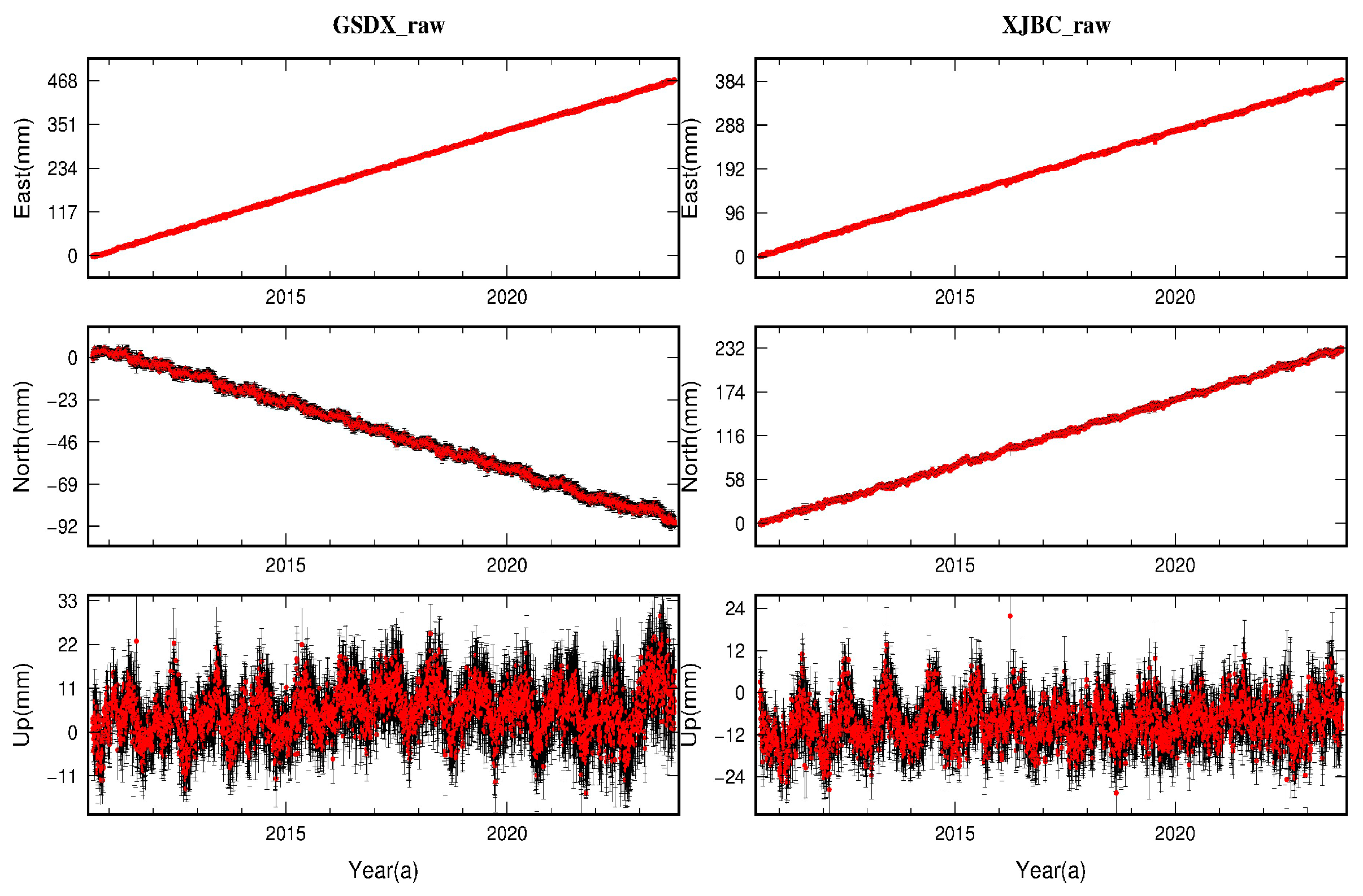

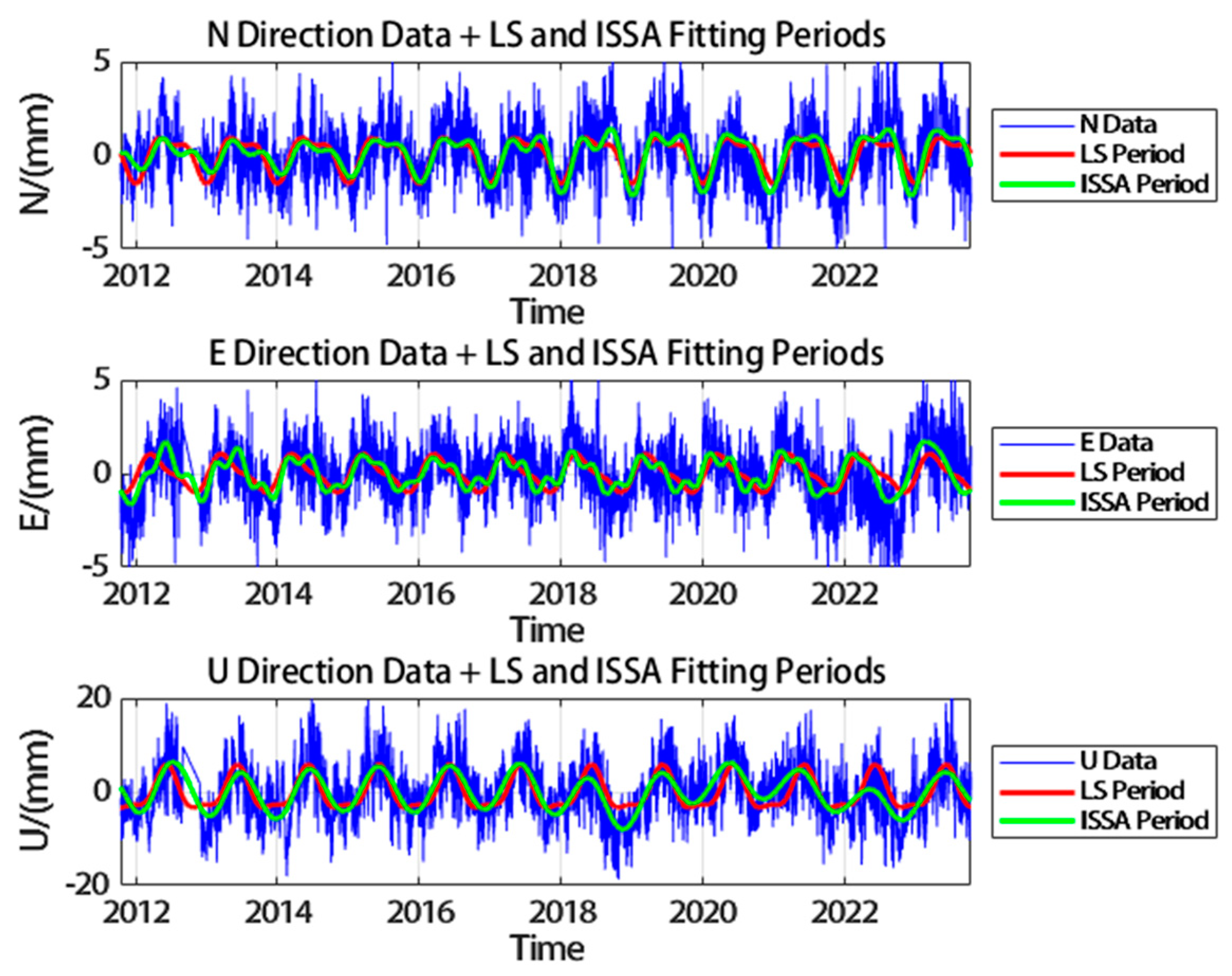
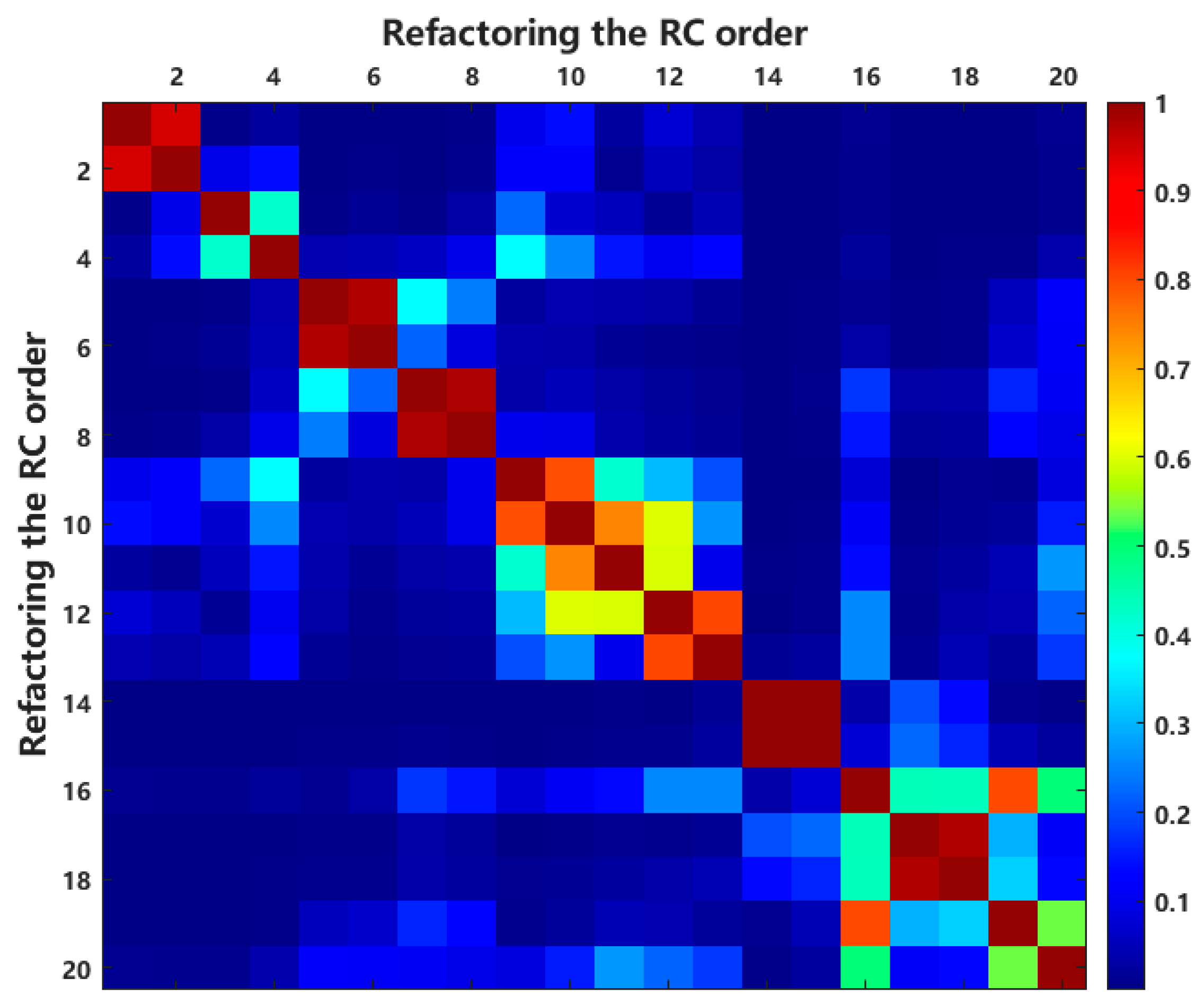

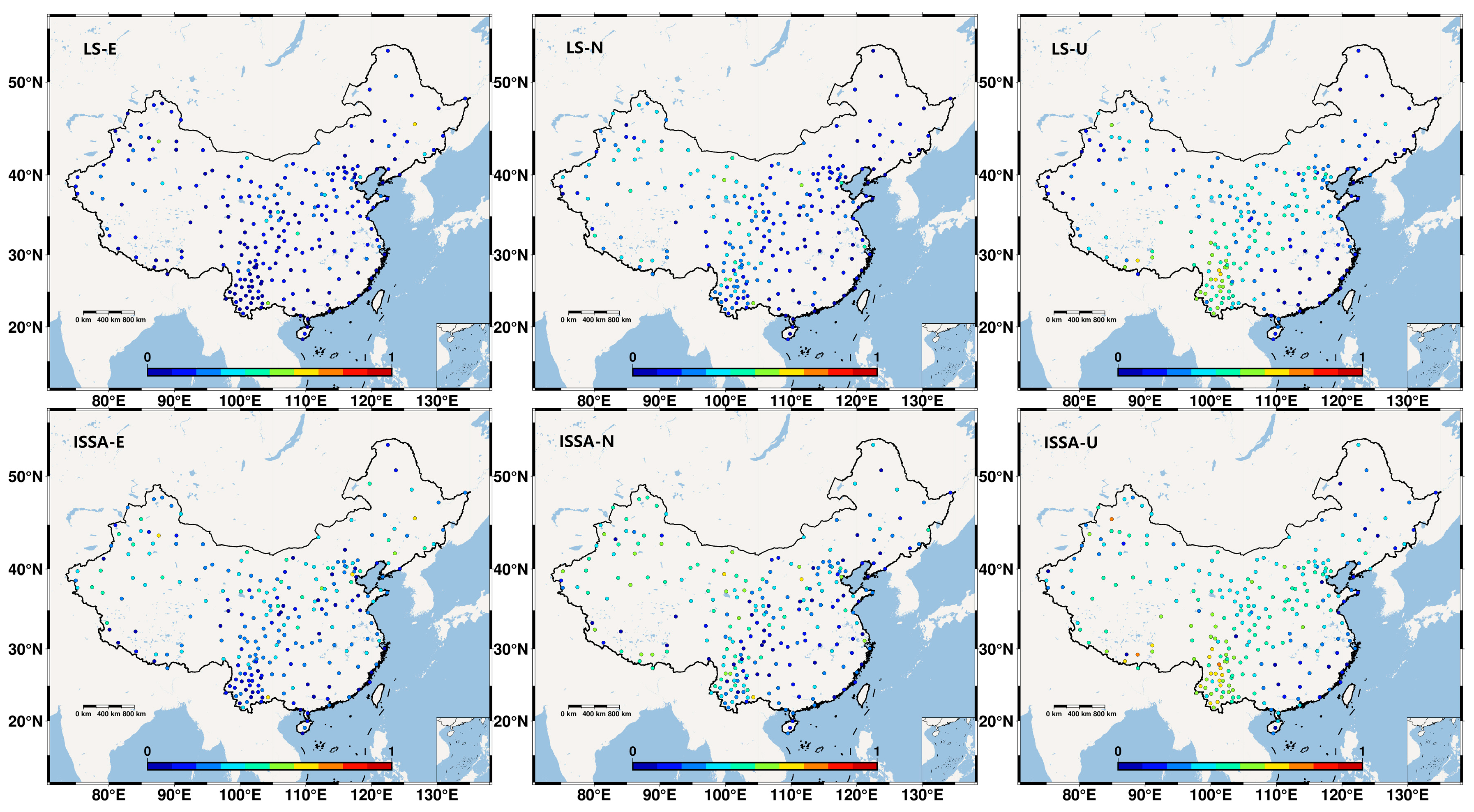

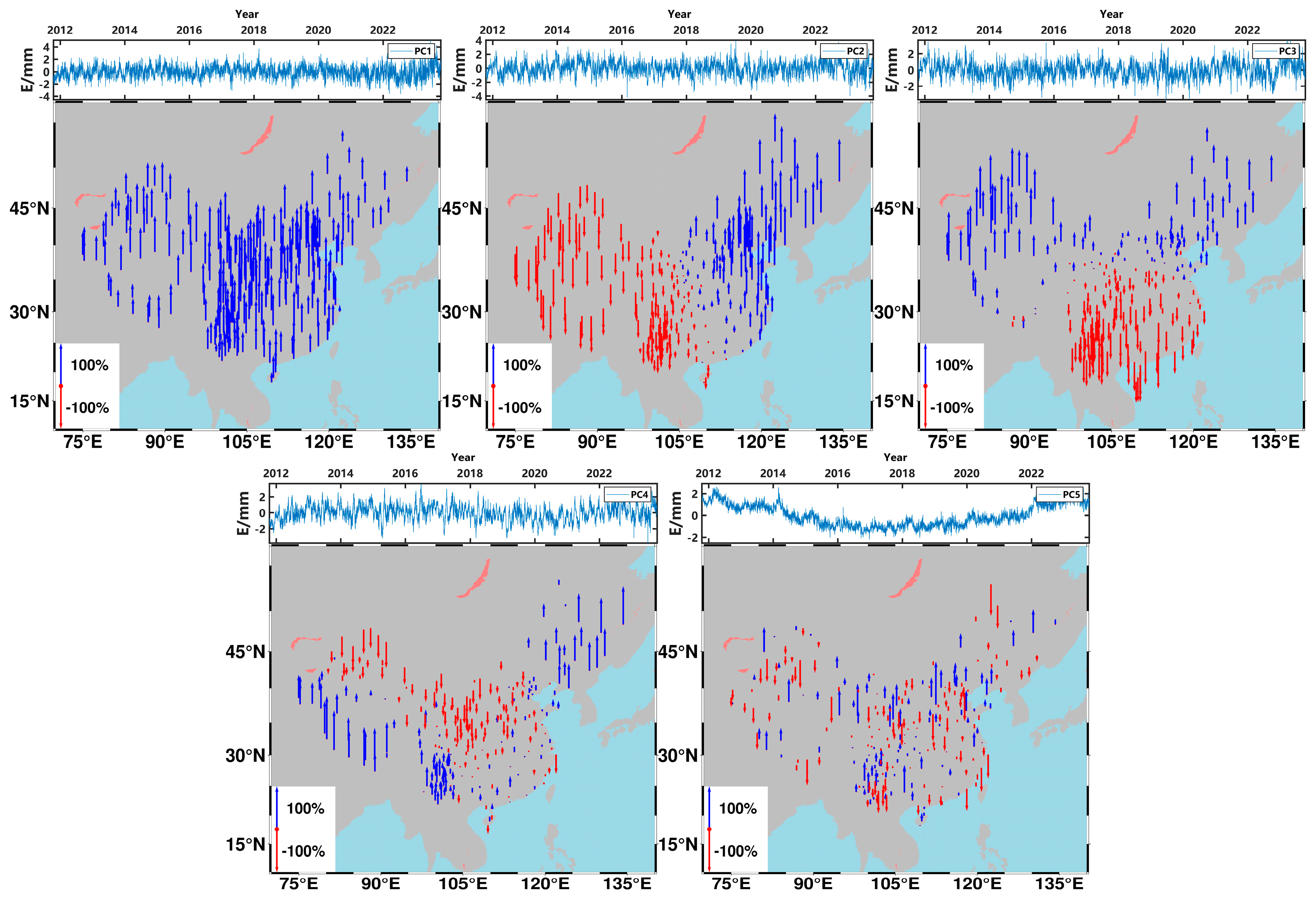



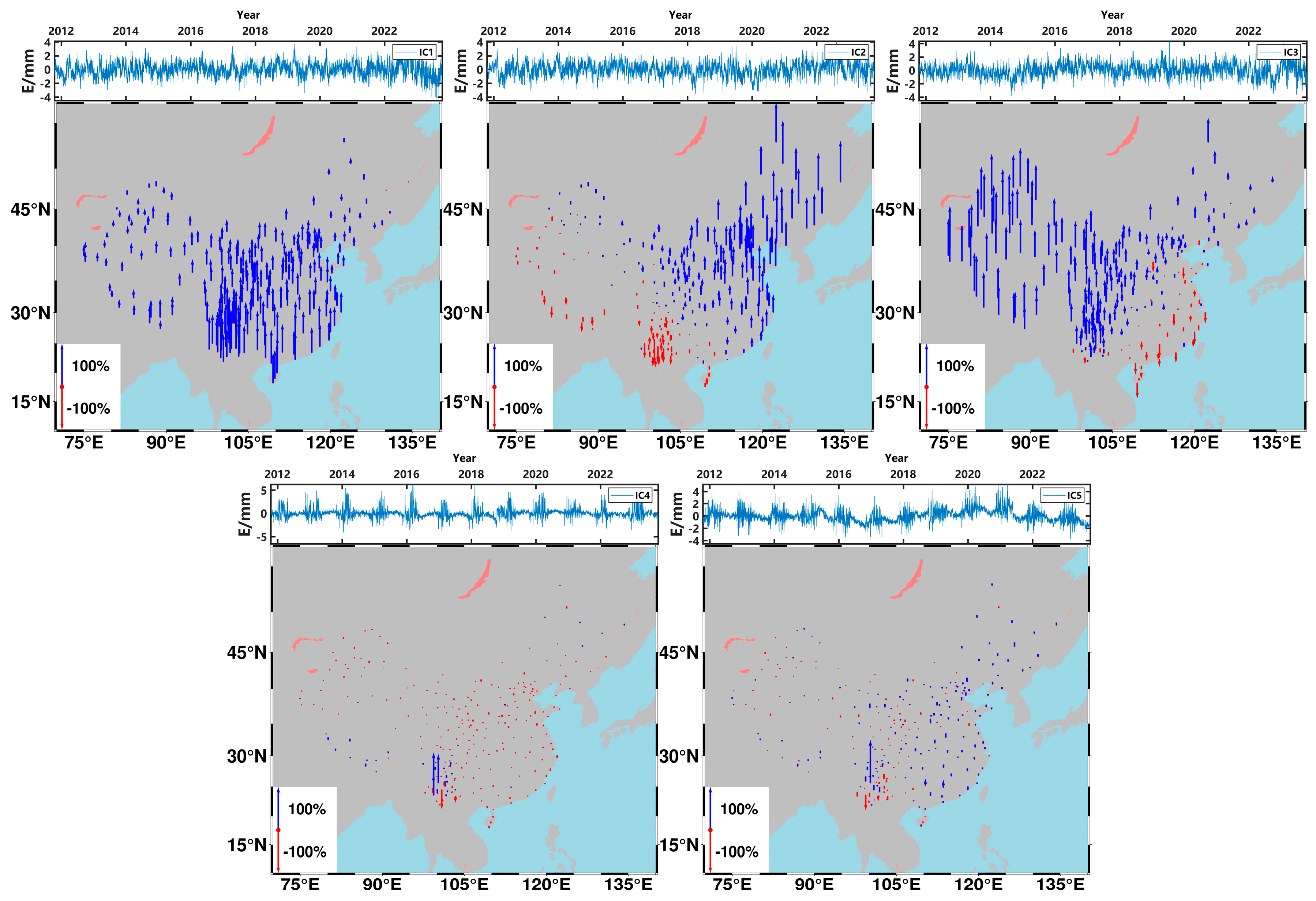
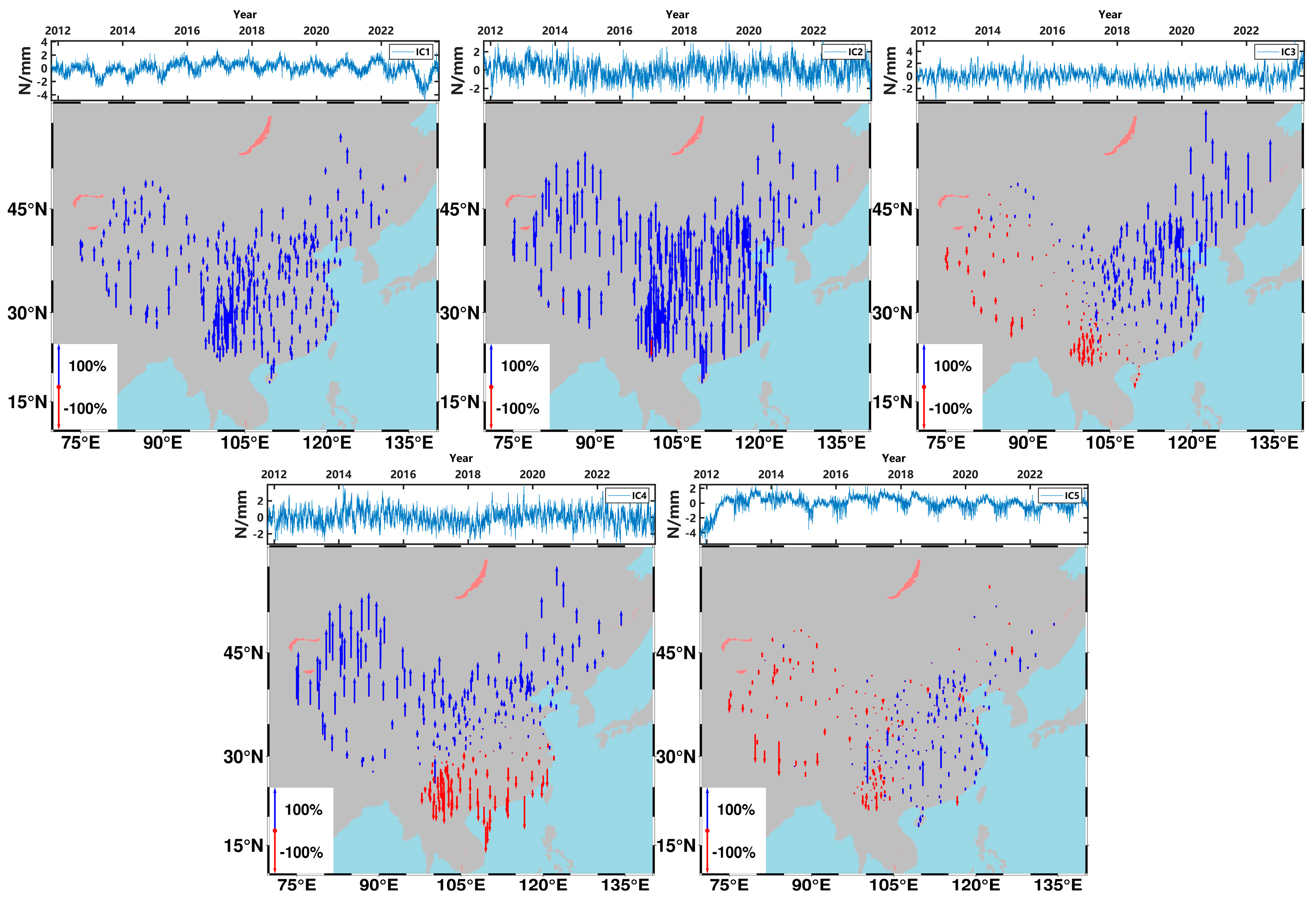

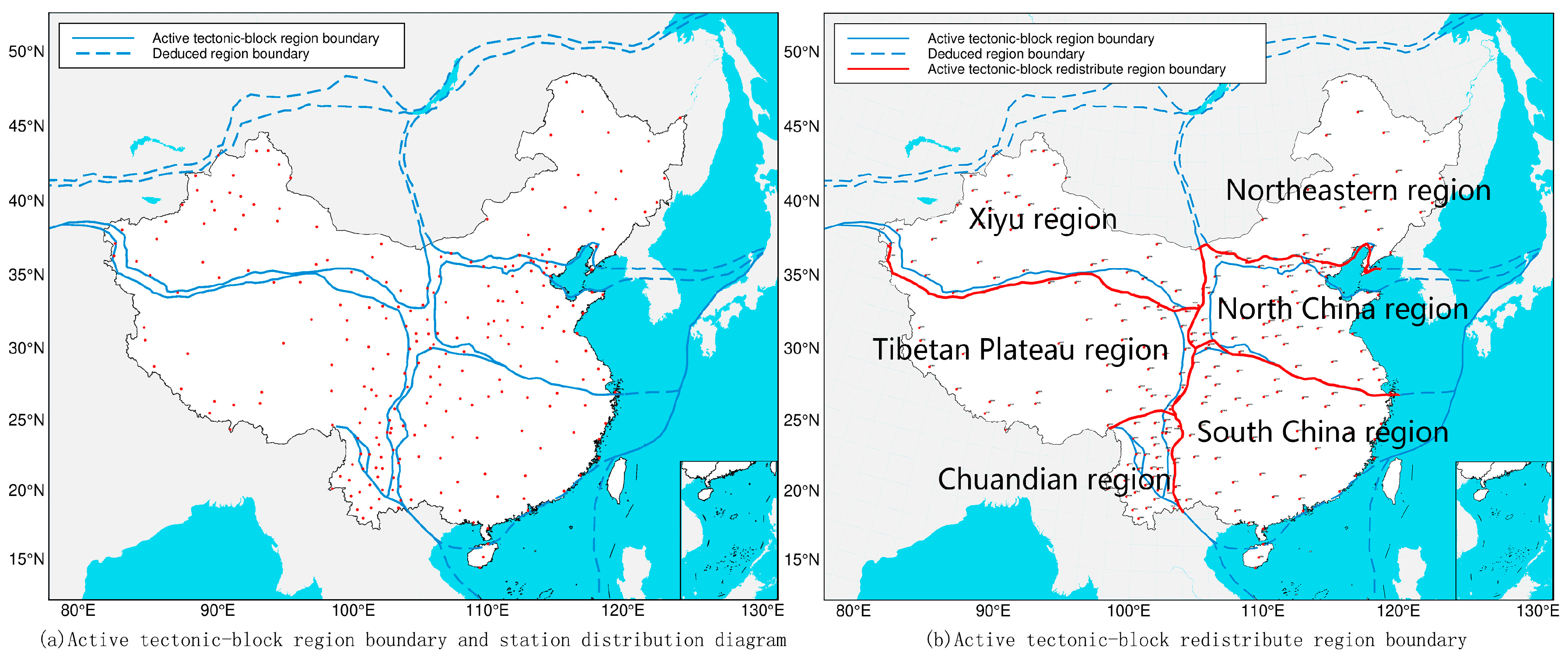
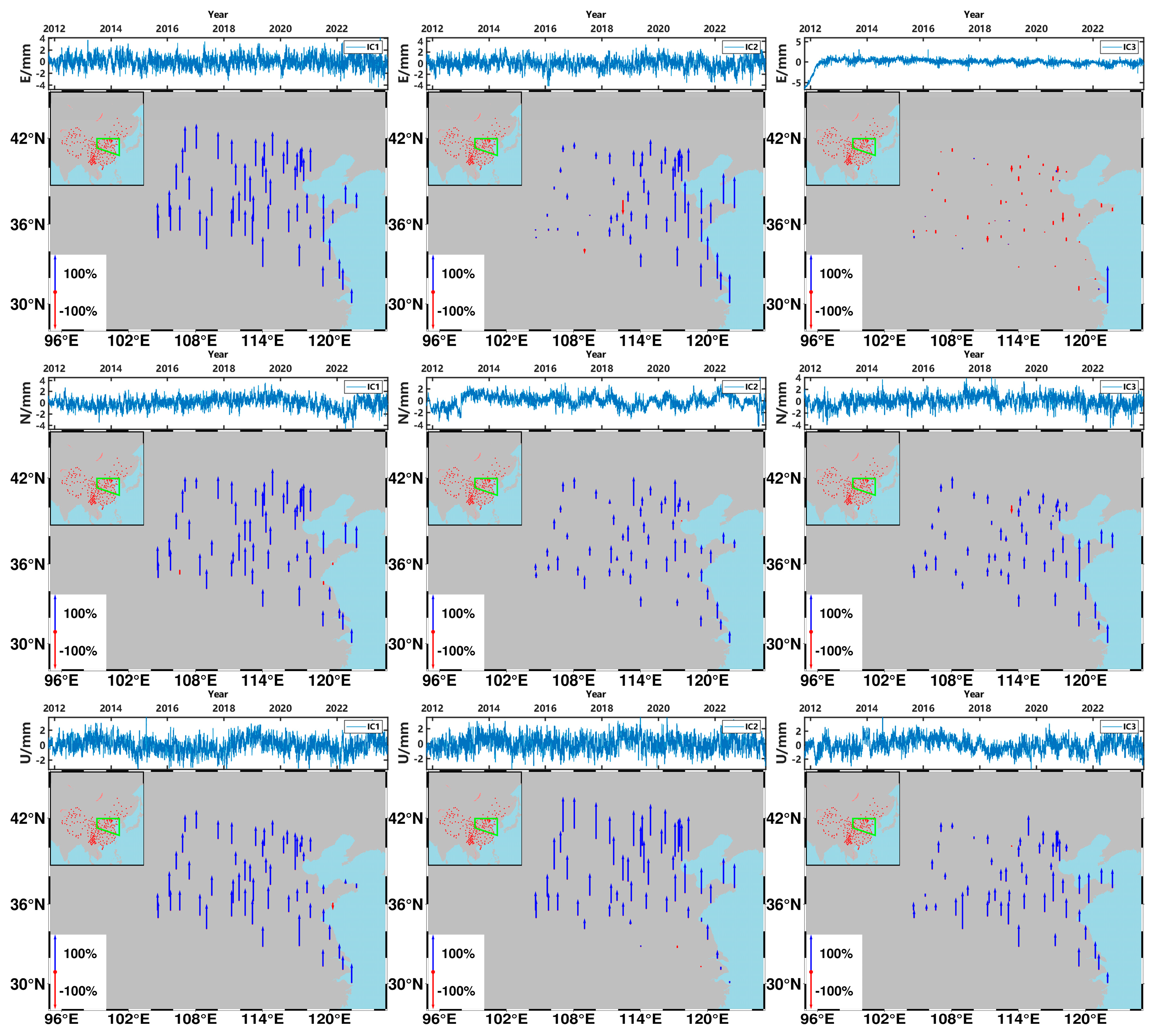
| PCA | ICA | ||||||
|---|---|---|---|---|---|---|---|
| E (%) | N (%) | U (%) | E (%) | N (%) | U (%) | ||
| PC1 | 26.11 | 31.51 | 24.52 | IC1 | 19.37 | 26.59 | 21.18 |
| PC2 | 7.90 | 6.55 | 7.77 | IC2 | 6.76 | 7.08 | 8.67 |
| PC3 | 4.45 | 5.27 | 6.54 | IC3 | 5.03 | 4.91 | 5.00 |
| PC4 | 2.42 | 2.67 | 2.88 | IC4 | 3.88 | 3.44 | 2.86 |
| PC5 | 2.32 | 2.25 | 2.05 | IC5 | 3.51 | 2.73 | 2.42 |
| CCR | 43.20 | 48.25 | 43.76 | CCR | 38.55 | 44.75 | 40.13 |
| TJBD | NXYC | GSTS | XJBL | |||||
|---|---|---|---|---|---|---|---|---|
| Northeastern Region (%) | North China Region (%) | North China Region (%) | Xiyu Region (%) | North China Region (%) | South China Region (%) | Xiyu Region (%) | Tibetan Plateau Region (%) | |
| E | 42.44 | 50.32 | 67.18 | 0.65 | 6.92 | 58.84 | 100 | 59.98 |
| N | 41.37 | 64.59 | 51.56 | 42.82 | 30.69 | 76.28 | 81.77 | 56.20 |
| U | 51.15 | 84.86 | 73.99 | 21.38 | 68.47 | 68.70 | 59.10 | 49.74 |
| GPS Network | E | N | U |
|---|---|---|---|
| Chuandian region | IC1 | IC1 | IC1, IC2 |
| Northeastern region | IC1, IC2, IC3, IC4, IC5 | IC1, IC2, IC3 | IC1, IC2, IC3, IC4, IC5 |
| North China region | IC1, IC2 | IC1, IC2, IC3 | IC1, IC2, IC3 |
| South China region | IC1, IC2, IC3 | IC1, IC2, IC3 | IC1, IC2, IC3, IC4, IC5 |
| Tibetan Plateau region | IC1, IC2 | IC1, IC2 | IC1, IC2, IC3, IC4 |
| Xiyu region | IC1, IC2, IC3 | IC1, IC2, IC3 | IC1, IC2, IC3, IC4 |
| Directional | Whole Entity (%) | Sub-Regions | ||||||
|---|---|---|---|---|---|---|---|---|
| Chuandian Region (%) | Northeastern Region (%) | North China Region (%) | South China Region (%) | Tibetan Plateau Region (%) | Xiyu Region (%) | Average (%) | ||
| E | 20.28 | 14.61 | 43.58 | 22.96 | 20.85 | 20.68 | 34.48 | 26.19 |
| N | 25.56 | 18.30 | 35.95 | 25.10 | 20.75 | 22.95 | 38.66 | 26.95 |
| U | 20.25 | 18.76 | 41.17 | 23.54 | 22.83 | 26.87 | 36.73 | 28.32 |
Disclaimer/Publisher’s Note: The statements, opinions and data contained in all publications are solely those of the individual author(s) and contributor(s) and not of MDPI and/or the editor(s). MDPI and/or the editor(s) disclaim responsibility for any injury to people or property resulting from any ideas, methods, instructions or products referred to in the content. |
© 2024 by the authors. Licensee MDPI, Basel, Switzerland. This article is an open access article distributed under the terms and conditions of the Creative Commons Attribution (CC BY) license (https://creativecommons.org/licenses/by/4.0/).
Share and Cite
Bai, B.; Xiao, G.; Miao, P.; Shuai, F.; Liu, C. CMONOC II Common Mode Error Analysis and Structural Region Division Research. Remote Sens. 2024, 16, 2135. https://doi.org/10.3390/rs16122135
Bai B, Xiao G, Miao P, Shuai F, Liu C. CMONOC II Common Mode Error Analysis and Structural Region Division Research. Remote Sensing. 2024; 16(12):2135. https://doi.org/10.3390/rs16122135
Chicago/Turabian StyleBai, Buang, Genru Xiao, Peiyu Miao, Fei Shuai, and Chenhui Liu. 2024. "CMONOC II Common Mode Error Analysis and Structural Region Division Research" Remote Sensing 16, no. 12: 2135. https://doi.org/10.3390/rs16122135






